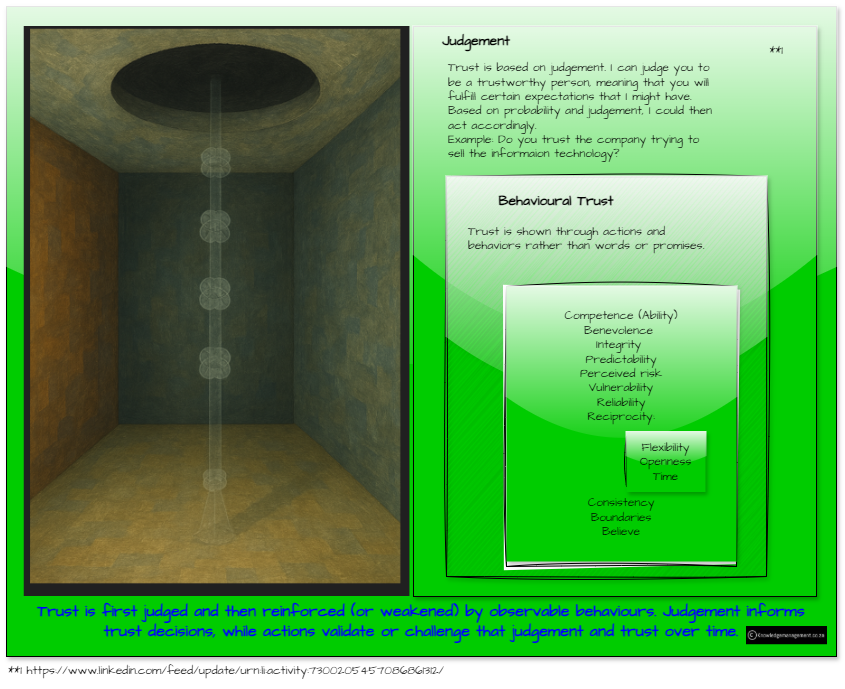Trust is one of the most important pillars of Knowledge Management, without trust knowledge sharing is very limited.
Having listened to the TrustTalk podcast, 'Measuring
Trust' with Paul C. Bauer, and the ongoing issues regarding the definition of
trust, I decided to explain trust using a metaphor.
In a room, an invisible rope hangs through a hole in the ceiling. A person tells you to climb this invisible rope into the unknown, telling that you will find what you are looking for.

You, the trustor, will consider a lot of factors before making a decision to actually climb this invisible rope. Without you even knowing it, you will consider all the above trust attributes.
Trust is like an invisible rope hanging through a hole from the ceiling of a room. You stand beneath it, staring up, uncertain. A person—the trustor—tells you to climb. "There is an invisible rope that will take you where you need to go," they say. But can you believe them?
Your judgement begins. You assess the invisible rope’s competence—does it exist? You consider the trustor’s integrity—do they have a history of honesty? Their benevolence—do they truly want what’s best for you, or do they have their own motives?
But judgement alone isn't enough. You must act. Reaching out, you grasp the invisible rope’s reliability. It feels solid, but your perceived risk is real—if it snaps, you’ll fall. In that moment, your vulnerability is exposed. Yet, if the rope holds, your belief in it grows.
As you climb, step by step, predictability and consistency shape your trust. Each firm grip reassures you. But if the rope frays or the trustor’s guidance wavers, doubt seeps in. The rope, like trust, must respect boundaries—it should support you without false promises.
And if trust is mutual—if you climb carefully and the trustor offers steady encouragement—reciprocity (Trust, Flexibility, Openness, Time investment) emerges. You no longer just rely on the rope; you commit to it. The journey becomes easier, not because fear disappears, but because trust holds and your expected outcomes are realized.
Practical implications:
In any scenario, it is important to know what role the Trustee and Trustor have. For example, is the Trustee a salesperson attempting to sell information technology to the organization (Trustor), perhaps even selling knowledge? There are numerous different hats that the Trustor and Trustee can wear. Trust influences every relationship, which may seem obvious and a matter of common sense, but measuring trust is not that easy. In academia, there are various types of trust, and the perspective may vary depending on the academic field being researched, but the principles remain the same. The example above points to interpersonal trust and information technology trust.
Coming back to measuring trust. For example, how can trust be measured between different business functions operating under the same company umbrella? To be able to do this, you will first need boundary spanners and knowledge workers within each organizational business function. Yes, KM starts with people.
Depending on the types of roles or 'hats' the Trustor and Trustee hold, these functions should create trust surveys based on the trust attributes mentioned in this article. Avoid using the term 'audits,' as it can feel intrusive to employees.
Conclusion:
Trust is first judged and then reinforced (or weakened) by observable behaviours. Judgement informs trust decisions, while actions validate or challenge that judgement and trust over time.
**1 https://www.linkedin.com/feed/update/urn:li:activity:7300205457086861312/

